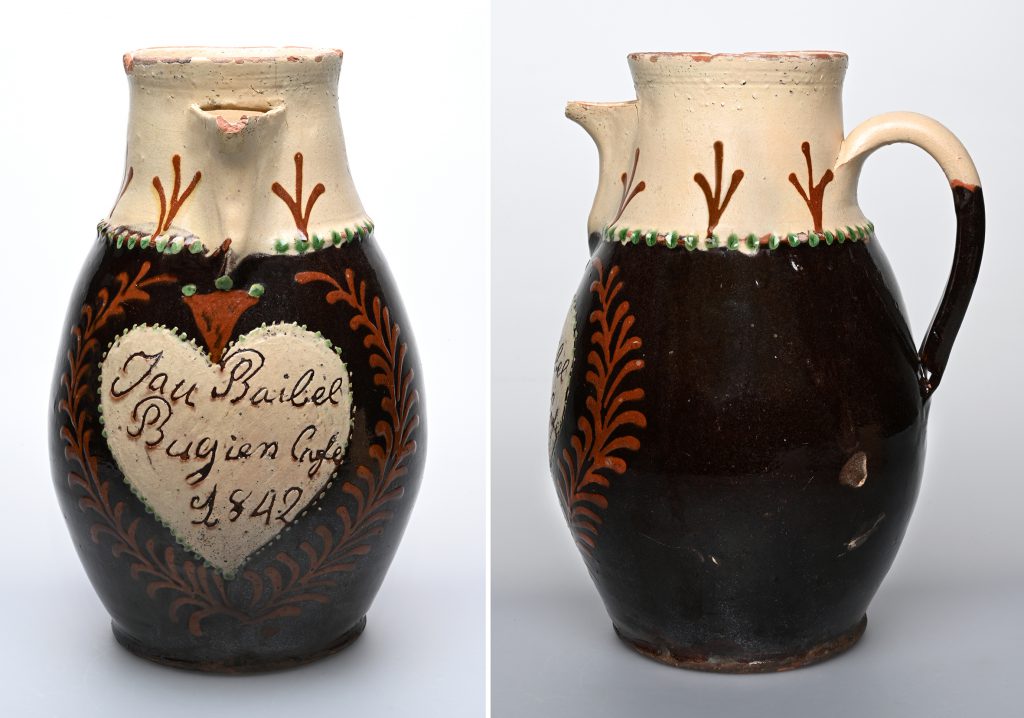
Jau Baibel Bugien Cafe 1842 – Ich trinke gern Kaffee! Sicher das eindrucksvollste Werk von Sep Antoni Deragisch aus Bugnei.
Pottery from Bugnei in CERAMICA CH
Andreas Heege, 2019
The potter’s workshop in Bugnei, municipality of Tavetsch in the Surselva district of the Bündner Oberland region at the foot of the Operalp Pass can be traced back to Sep (Josef) Antoni Deragisch (born 13th March 1815, died 6th August 1882, according to HLS), the son of a Roman Catholic farmer (all information based on: Curti 1920; Gadola/Curti 1929; Frei 1947, 31; Creux 1970, 128–129, cat. 4 and 5; Schnyder 1979, 331. Further information courtesy of Tarcisi Hendry, Museum La Truaisch, Sedrun. Unpublished: Haldner 1982. Providing no additional independent information: Jenny 1991, 136; this text was first published in Heege 2016).
Sep Antoni Deragisch was apprenticed to potter Fidel Wölfle in Wangen in the Allgäu region of Germany. In 1920, the family still had his original journeyman’s certificate of 1834 (Curti 1920, 270, current whereabouts unknown). Having completed his apprenticeship, he set up a pottery at his home in the village where he was from.
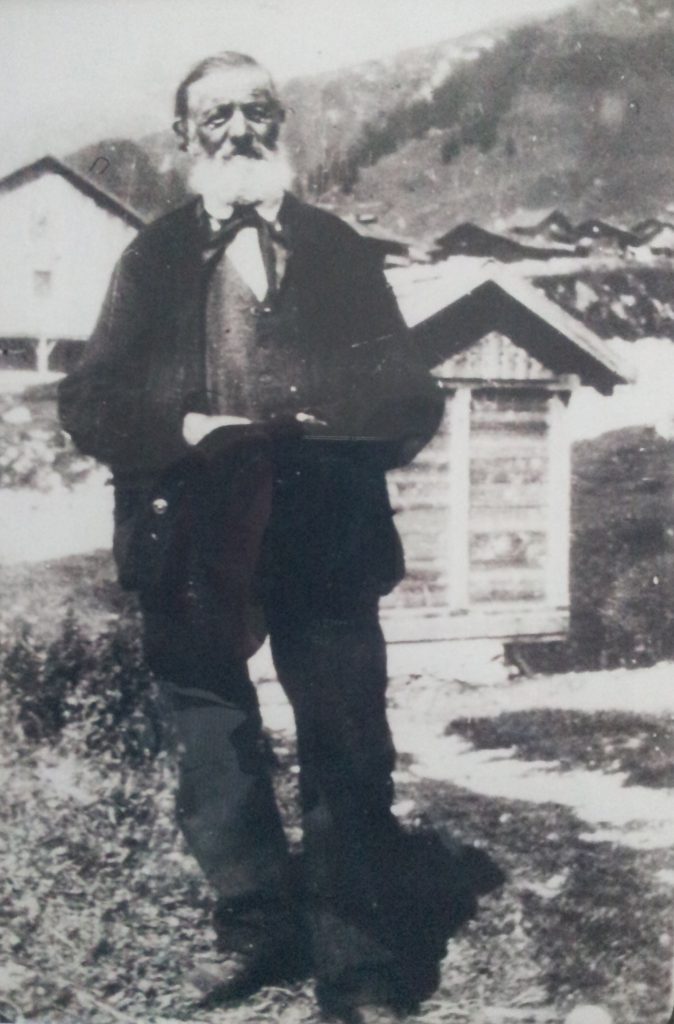
Sep Antoni jun. (born 21st September 1842, died 27th October 1930)
His son and successor, Sep Antoni jun. (born 21st September 1842, died 27th October 1930), who was apprenticed to an unknown master in Flüelen, probably closed down the workshop shortly after 1918, though it is not exactly clear when this was (Curti 1920). He is likely to have been the source of the information published by Father Notker Curti from the Benedictine Abbey of Disentis.

Overview of the basic range of products from Bugnei, collection of the Monastery Museum of Disentis.
The collections of the Rhaetian Museum in Chur, some of which came from Father Notker Curti and from Sep Antoni Deragisch jun. himself, and the main part of the collection of the Monastery Museum in Disentis give us an impression of the type of pottery that was produced at Bugnei. Similar objects can also be found in the collection of the Museum La Truaisch in Sedrun and in the Museum Nutli Hüschi in Klosters. A business ledger written in Romansh with entries from between 1866 and 1882 (and therefore probably by Sep Antoni Deragisch sen., Transcribed by Tarcisi Hendry, 2021) and a sketchbook with dates from 1875 (and therefore at least in part by Sep Antoni Deragisch jun.; RMC Inv. H1981.1134, H1982.12), which has not yet been analysed, have also survived. If Father Notker had this sketchbook in mind when he wrote his treatise in 1920, there is a discrepancy between the hand-written dates in the book and Notker’s attributions. He assumed that the sketches of tiled stoves, in particular, were made by Sep Antoni Deragisch sen. Because the book itself does not provide any proof to support this, he must have received the information from Deragisch jun.
The book also contains a technical section drawing of a typical upright potter’s kiln as one would have expected to find in the German-speaking part of Switzerland in the 19th century. It is not known, however, if the wood-fired kiln in Bugnei was of the same type.
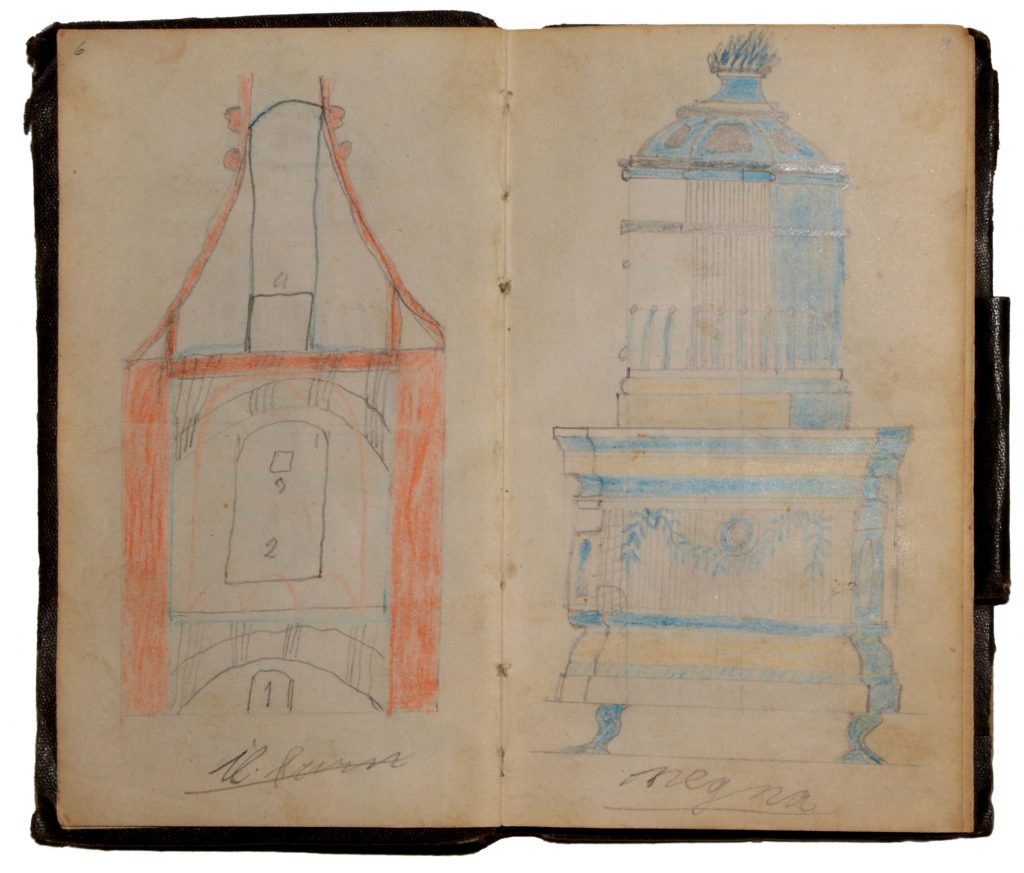
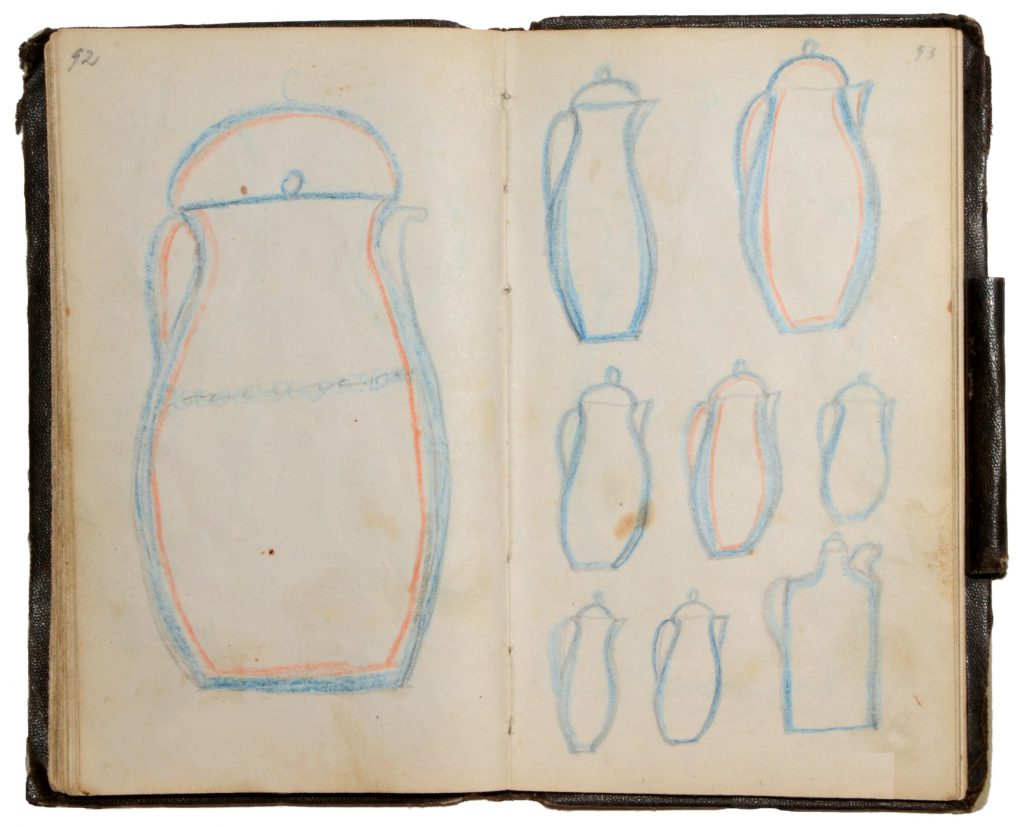
Sketchbook from the Rhaetian Museum: section drawing of a potter’s kiln, a tiled stove and utilitarian ware (RMC H1981.1134).
The book also contains numerous sketches of tiled stoves. Sep Antoni Deragisch sen. appears to have been particularly taken with the decorations and shapes of Biedermeier, Empire or historicism-style tiled stoves. At the same time, other technical details were noted in the book (e.g. about a water-wheel-driven potter’s wheel or glaze mill), as were sketches of vessel shapes that were apparently created in his own workshop.
Probably based on the monastery’s collection which he personally amassed and the pieces that he had found for the Rhaetian Museum in Chur, Father Notker made the following observations on the products from the Deragisch workshop:
“Unfortunately, the wares that are sold door-to-door do not have much to offer in terms of shapes or decorations. They can be divided into two groups: utilitarian vessels and decorative objects. The first group contains all the different pots, jugs and crocks, from simple, unglazed flowerpots to large coffee pots; the larger pieces are usually dark or almost black in colour [RMC Inv. H1971.459, KMDis Inv. 1999-350, U15, RMC Inv. H1971.451, H1971.460. All the pieces that are housed in the RMC today were acquired by Father Notker. Other typical bucket-handled spouted jugs are: KMDis Inv. 1999-347, U20, U22, U24, U32, RMC Inv. H1971.1174, H1973.885, H1984.3 (acquired in Rodels). Coffee and tea pots: KMDis Inv. 1999-351, U31, U34, RMC Inv. H1971.451, H1971.460], while the others are off-white or yellow-brown, and the flowerpots tend to be green [KMDis Inv. U16, 1999-344, U21–U23]. Decoration was sparingly applied in Bugnei, the black vessels are generally unadorned, while the lighter-coloured wares exhibit slender leafy wreaths, others exhibit Deragisch’s Empire-style artwork or fine patterns made up of dots [KMDis Inv. U1, U4, RMC Inv. H1971.477, KMDis Inv. U6. Other pieces that can probably be associated with Deragisch on the basis of style: KMDis Inv. 1999-346, U5, U18, U137 and U137a (cups, acquired in Bugnei in 1947), RMC Inv. H1964.233 (acquired in Trun in 1910), H1970.203, H1971.478, H1971.1164 (waster, acquired in Bugnei from the Deragisch workshop].

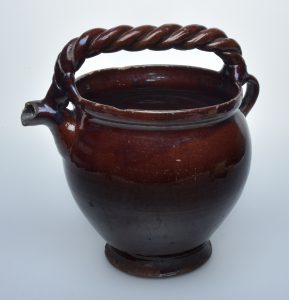

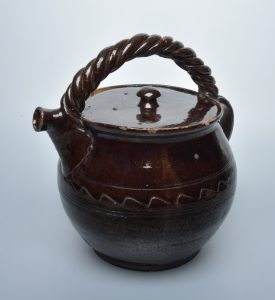
The only novel forms are the so-called broccas, although they do strike one as being rather antiquated. Mainly used for coffee today, they are peasant jugs with small round spouts and two handles, a small one opposite the spout, the other a twisted larger one for carrying the vessel. Since the latter would not have been strong enough to bear the weight of the jug when it was full, it was reinforced using wire or string fed through holes on the handle attachment sites. The ornamental objects were not particularly decorative, either in terms of their shapes or their colours.
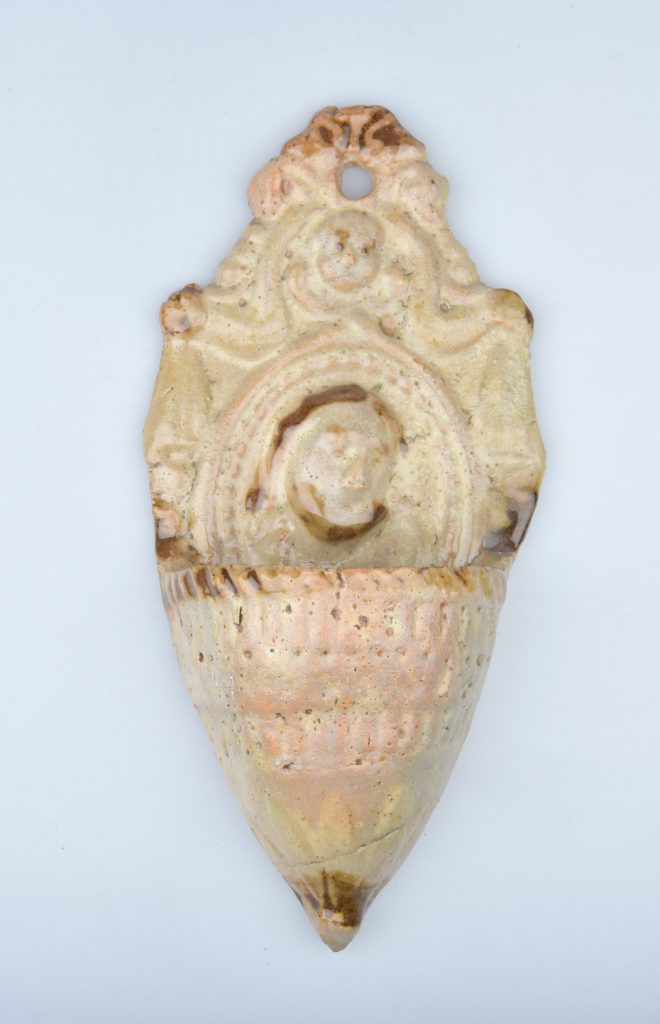
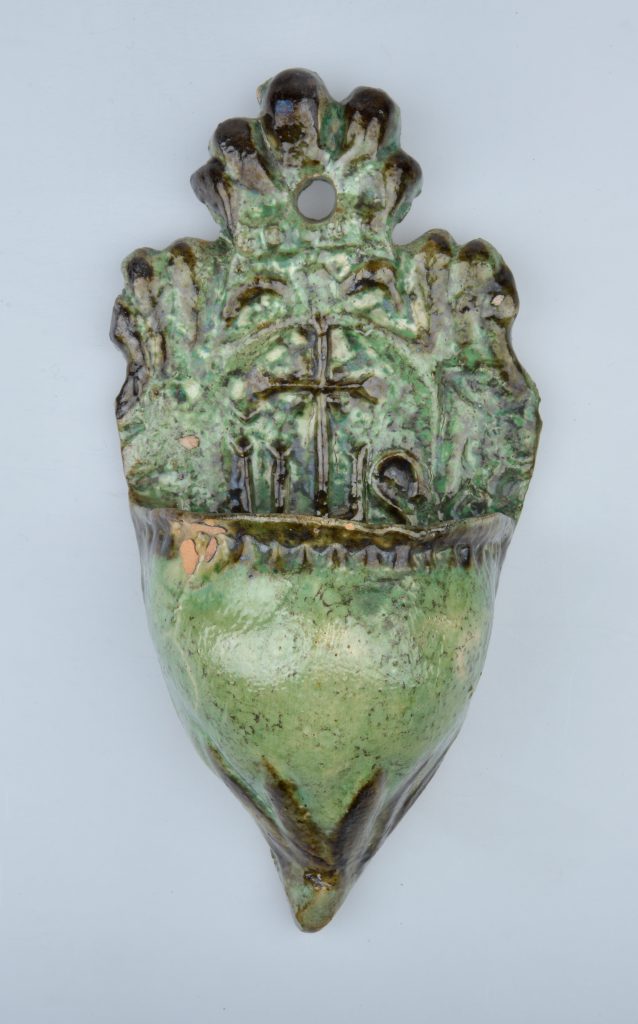
The rough and ready bénitiers [RMC Inv. H1970.216, H1970.217. Others: KMDis Inv. 1996-298, 1996-299, RMC Inv. H1971.474. The collection of the Abbey of Disentis includes a mould for the back of one of the fonts which bears the mark “JAD”: KMDis Inv. 1999-345], crucifixes [KMDis Inv. U109a], and small candleholders [poss. KMDis Inv. U7, RMC Inv. H1971.453] are all rather crude and some are not particularly pleasing when it comes to colour. The simple, dark-coloured inkstands decorated with round holes come across quite well in comparison [KMDis Inv. U10, and probably U26, acquired in Tavetsch 1926, U139, acquired in Bugnei 1947]. The picture frames made of twisted strands of blueish-purple and white clay are not bad at all [KMDis Inv. U122, and also KMDis Inv. U2]. Perhaps the best of all are the wash basins (butschidas in Romansh) with their garlands and festoons that act as lively reminders of the older Deragisch’s apprenticeship years [RMC Inv. H1973.455, very similar: KMDis Inv. U29]. Unfortunately, the colour, something between white and green, is often not particularly pleasing. In short, the products that were created in Tavetsch were geared towards a clientele that was looking for simple, cheap wares and did not make any great demands with regard to shapes and colours because the vessels were not intended for representational purposes…” (Curti 1920, 272–273).
There are also a number of features that Father Notker does not expand on. The bucket-handled spouted jugs sometimes have a number incised both into the bottom of the base and into the bottom of the matching lid. This obviously helped to find the actual lid for each individual vessel when unloading the kiln. Another feature worth mentioning is the fact that the black-brown vessels often exhibit incised wavy lines or rouletted decorations.
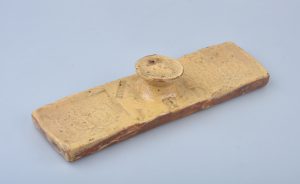
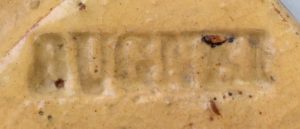
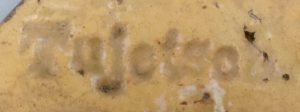
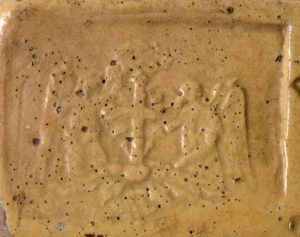
A paperweight in the collection of the Rhaetian Museum bears the imprinted initials of the maker, “J a D” as well as a rectangular imprint of a Sacred Heart depiction of Christ flanked by two angels as well as two impressed marks reading “BUGNEI” and “Tujetsch” respectively (RMC Inv. H1970.221, KMDis Inv. U13.). The same marks can also be found on one of the small single-handled jars and on an inkstand, which allows us to attribute them to the Deragisch workshop. The Sacred Heart motif can also be seen on the front of a small green candle holder, on the rectangular basin dated 1912, on the shoulder of a flowerpot (KMDis Inv. U21) and on the side of the crucifix pedestal. The front of the pedestal bears a faint imprint of a Lamb of God motif, and the same imprint can be found on the well of a shallow bowl with a bevelled rim (KMDis U006). The back of a match holder has an applied decoration in the form of a bust enclosed in a beaded ring (RMC H1971.453). The same bust can be found on a flowerpot (KMDis Inv. U23), which is also decorated with twisted strands, and on the ceramic surround of a small domestic altar (KMDis Inv. U150).

Tiled stove (h. 148 cm, w. 117 cm, d. 72 cm), which was still in the Deragisch home at 5 Via Romana in Bugnei until September 1980. Fragments of wall tiles with exactly the same pattern survive in the collection of the Museum Al Truaisch in Sedrun.
The Deragischs also appear to have created tiled stoves, although it is not known how many, with green, yellow or black-brown tiles, some of which also exhibited a zigzag pattern (single tile RMC Inv. HXIII.220, acquired by Father Notker, Disentis; other tiles are housed in the Museum in Sedrun). The pattern, which can also be found on a rectangular box with cord ornament (RMC H1971.454), was made using a plaster mould which is now in the collection of the Rhaetian Museum (RMC HXIII.227). The cornice-tiles were often dark-brown in colour and decorated with slender garlands of flowers. At least that was what the stove in the Deragisch household looked like (Curti 1920, 272–273). When the house underwent renovation work in 1980, the stove was transferred to the Rhaetian Museum (Jenny 1991, Fig. p. 131; RMC H1980.224).
According to Father Notker Curti, Sep Antoni Deragisch sold his pottery throughout the entire Bündner Oberland region between Bugnei and Ilanz. At times he had pottery repositories in Ilanz, Disentis and Trun. We do not know if some of his wares perhaps found their way to buyers in Chur or even further down the River Rhine in Liechtenstein. The remote location of the Tavetsch workshop mainly reflects the typological elements and decorative trends of the 19th century in the German-speaking part of Switzerland and southern Germany, albeit in a distinctly original manner.
Acknowledgements
I would like to thank Father Theo Theiler for giving me access to the objects from the KMDis, allowing me to catalogue the entire monastery collection in 2020. The SNM also has two objects in its collection (a ceramic cooking stove for children; a jug), both of which are believed to have been made in Bugnei (SNM Inv. LM-60575, LM-114745). A private collection in Flims-Waldhaus, which I have not had access to, is said to include further pieces (Creux 1970, 129 Kat. 4). I would like to thank Konrad Schmid in Chur for allowing me to examine his small handsome collection. Further ceramic objects are in the Museum of Cultures in Basel and in the museums of Ilanz, Sedrun, Trun and Klosters. Livia Deragisch from Bugnei is due to examine the family-owned objects in the near future.
Translation Sandy Haemmerle
New publication:
Hendry/Heege 2022
Tarcisi Hendry/Andreas Heege, Vischala da Bugnei – Keramik aus Bugnei, La historia dall hafnaria Deragisch (1835-1920) – Die Geschichte der Hafnerei Deragisch (1835-1920). Sedrun 2022.
References:
Creux 1970
René Creux, Volkskunst in der Schweiz, Paudex 1970.
Curti 1920
Notker Curti, Eine Töpferei im Tavetsch, in: Bündnerisches Monatsblatt, 1920, Heft 9, 269-273.
Frei 1947
Karl Frei, Keramik des Mittelalters und der Neuzeit, in: Kunstgewerbemuseum Zürich (Hrsg.), Ausstellung Schweizerische Keramik von der Urzeit bis heute, Zürich 1947, 27-46.
Gadola/Curti 1929
Guglielm Gadola/Notker Curti, La Fabrica da vischalla da tiara cotga a Bugnei, in: Il Glogn, calender dil pievel, annalas per historia, litteratura e cultura romontscha 3, 1929, 34-37.
Haldner 1982
Priska Haldner, Die Töpferei von Sep Antoni Deragisch in Bugnei Tavetsch. Maschinenschriftliches Manuskript im Rätischen Museum Chur, 1982, Chur.
Heege 2016
Andreas Heege, Die Ausgrabungen auf dem Kirchhügel von Bendern, Gemeinde Gamprin, Fürstentum Liechtenstein. Bd. 2: Geschirrkeramik 12. bis 20. Jahrhundert, Vaduz 2016.
Jenny 1991
Valentin Jenny, Handwerk und Industrie in Graubünden im 19. Jahrhundert. Bestrebungen zur Förderung von Handwerk und Einführung von Industrie als Massnahme zur Hebung des Volkswohlstandes, Chur 1991.
Schnyder 1979
Rudolf Schnyder, Bündner Keramik-, Glas und Lavezsteingewerbe, in: Hans Erb, Das Rätische Museum, ein Spiegel von Bündens Kultur und Geschichte, Chur 1979, 328-347.

